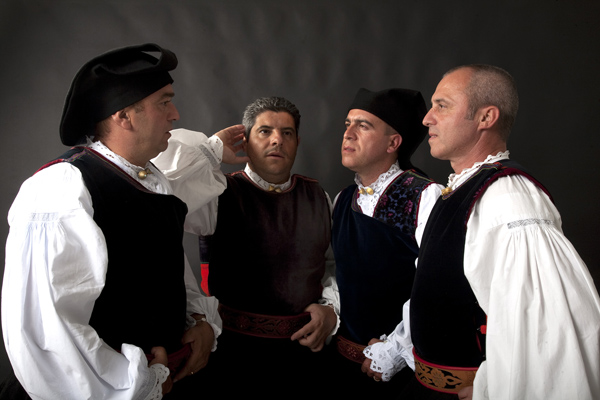In Celebration of the Human Voice - The Essential Musical Instrument
Home | Doo Wop | Barbershop | World | Contemporary | Christian | Vocal Jazz | Choral | Christmas | Instructional | Arrangements
Classical | Opera | Musicals | Personality | Young Singers | Disney | Videos | Songs | The Artists

Tenores di Bitti

Group.
The Tenores di Bitti "Mialinu Pira" have a special place amongst the many groups in Sardinia. Having a style which is slightly less rough than that of other quartets, exemplary researchers in their heritage, impeccable executors with exceptional vocal quality, adorable people, they have reached a level of excellence and of admiration which is without equal in Sardinia and in the whole world. Their frequent performances on so many national television programs are to be remembered. In the last few years they've been touring extensively Europe (France, Germany, Denmark, Norway, Czech Republic, Spain, Belgium, Nederland, Austria, Luxembourg, Slovenia, Swiss, Ireland, Croatia, Serbia, Lithuania, Tunisia, Hunghery, United Arab Emirates, Brazil and Japan). It is also remarkable their participation in 2001 to the Christmas Concert in the Vatican for the Pope Giovanni Paolo II, the concert on May 2009 in the Concertgebouw Theatre in Amsterdam and in December in the Church of the Nativity in Bethlehem. The Tenores di Bitti "Mialinu Pira", having performed for so many years, is nowadays considered from music-fans and etno-musicologists the most prominent example of this vocal art. There are many points that make them so special : the cantu a tenore is still well alive in Sardinia performed by many groups, most of them are old singers performing traditional texts. Their young age is a first approach to notice how their sound, harsh and ancestral, is in fact very homogeneous. Their perfect tuning and their powerful sound is very rare today, because this skill needs years of practice and passion to be performed at its best.
Another matter to be pointed is their accuracy in choosing lyrics. Both in dancing (lestru, dillu, seriu, passu torrau,) and slow (isterrita, boch'e notte) forms, the lyrics , by famous poets or from misknown contemporary authors, make the repertoire of Tenores di Bitti "Mialinu Pira" an important vehicle of literary transmission. These songs are profane poems speaking about the shepherds and their solitude in touch with the nature, referring to the popular world and its traditions. The religious' songs are performed in church, in particular moments of the liturgical year (Christmas, Easter or patronal feasts) or during the religious processions through the street of the village of Bitti. The Grobbes and some lullabies for Baby Jesus (su Nenneddu) belong to this repertoire.
Select a Category |
Want to Sing? - Find a Chorus Near You
List of Choruses by State | List of Choruses by City
